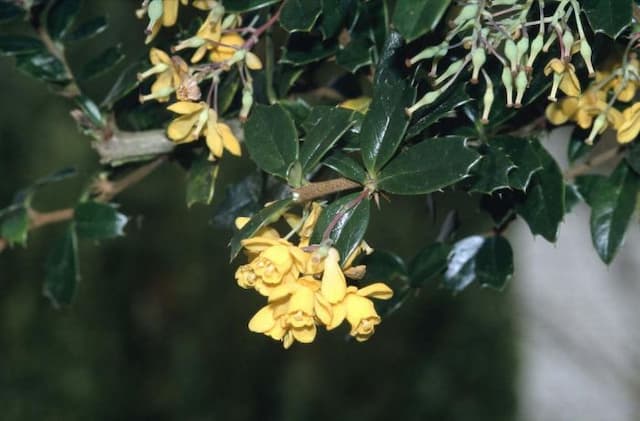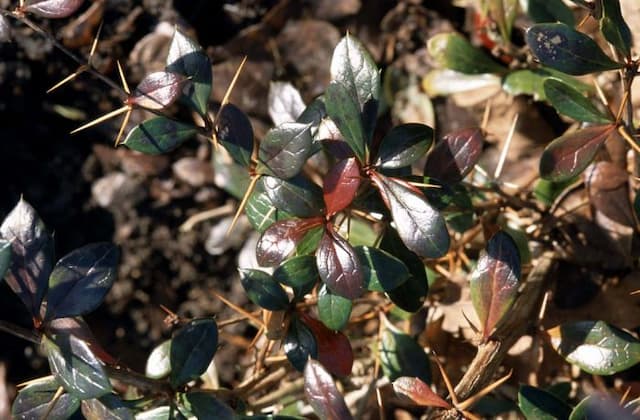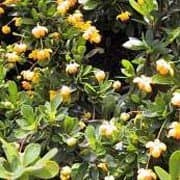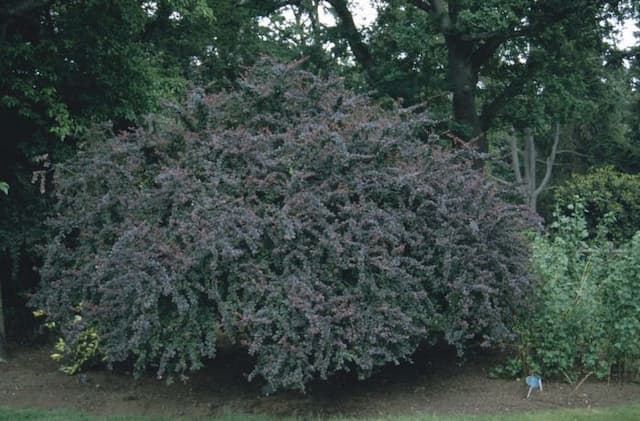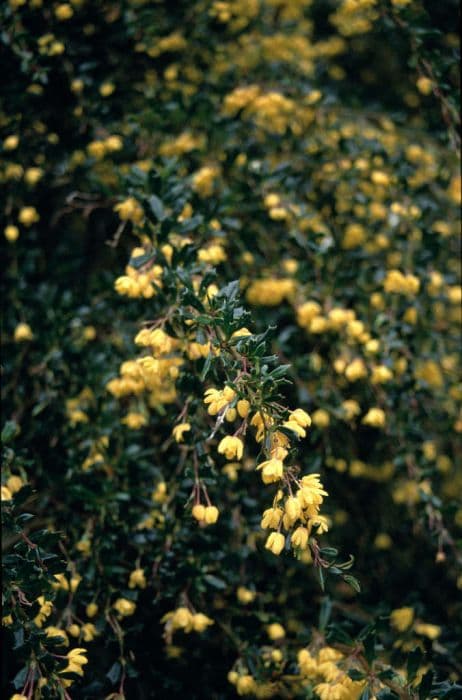Oregon grape Mahonia × media

ABOUT
Mahonia × media, commonly known as Oregon grape, is an evergreen shrub with a striking appearance that adds visual interest to gardens throughout the seasons. The plant’s most distinctive feature is its pinnate leaves, which are reminiscent of holly with their spiny-toothed leaflets. These leaves are dark green in color, adding a lush, deep tone to the plant's overall look. During the cooler months, the leaves may take on a bronze or purplish tint, further enhancing the Oregon grape's winter interest. Early in the season, the plant produces dense clusters of bright yellow flowers, which stand out vividly against the dark foliage. These flowers are often small, with multiple petals radiating from the center, creating a star-like shape. As the seasons progress, the flowers give way to dark blue-purple berries, which are quite attractive to birds and other wildlife. These berries are also a feature of the plant, contributing to its common name due to their resemblance to grapes. Overall, the Oregon grape’s combination of dramatic, holly-like foliage, vibrant yellow flowers, and dark berries gives it a varied and interesting profile in the garden throughout the year.
About this plant
 Names
NamesFamily
Berberidaceae
Synonyms
Charity Mahonia, Arthur Menzies, Winter Sun
Common names
Mahonia × media.
 Characteristics
CharacteristicsLife cycle
Perennials
Foliage type
Evergreen
Color of leaves
Dark green
Flower color
Yellow
Height
7 feet (2.1 meters)
Spread
5 feet (1.5 meters)
Plant type
Shrub
Hardiness zones
7
Native area
Cultivar
Benefits
 General Benefits
General Benefits- Attractive Ornamental Plant: Mahonia × media, also known as Oregon grape, adds aesthetic value to gardens with its evergreen foliage, bright yellow flowers, and blue-black berries.
- Habitat for Wildlife: It provides food and shelter for birds and beneficial insects.
- Low Maintenance: Oregon grape is a hardy plant that requires minimal care once established, making it ideal for low-maintenance landscapes.
- Drought Resistance: This plant is drought-tolerant, making it suitable for xeriscaping and water-conservation gardens.
- Shade Tolerance: It can grow in partial to full shade, offering flexibility in garden design and plant placement.
- Erosion Control: Oregon grape's roots help stabilize soil on slopes and prevent erosion.
- Winter Interest: With its evergreen leaves and persistent fruits, it provides color and interest in the garden even during the colder months.
 Medical Properties
Medical Properties- Antibacterial: Mahonia × media contains alkaloids such as berberine which have been found to have antibacterial properties.
- Antifungal: The plant has been known for its antifungal activity, possibly due to the same alkaloids that contribute to its antibacterial effects.
- Anti-inflammatory: Some components in Mahonia × media may help reduce inflammation, making it beneficial for treating certain skin conditions.
- Antioxidant: The plant may contain compounds with antioxidant properties that can help protect the body from oxidative stress and free radicals.
 Air-purifying Qualities
Air-purifying QualitiesThis plant is not specifically known for air purifying qualities.
 Other Uses
Other Uses- Mahonia × media, commonly known as Oregon grape, can be used as a natural dye. The berries produce a blue or purple dye that is useful for coloring fabrics or leather.
- The wood of the Oregon grape is very dense and can be used to make small woodworking objects such as tool handles, inlay work, or decorative items.
- The spiny leaves of the Oregon grape can be used to create barriers or hedging to deter human or animal trespassers due to their prickly texture.
- During the winter, the evergreen foliage of the Oregon grape can be used in Christmas wreaths and holiday decorations for a touch of natural greenery.
- Its bright yellow flowers can be a source of natural yellow coloring in crafts, such as egg dyeing or fabric staining.
- When pruned and shaped carefully, Oregon grape can be used for bonsai, offering a distinctive and hardy species for enthusiasts of the art.
- The berries of the Oregon grape, due to their tartness, can be used as a substitute for barberries in Persian cuisine, where it's known as zereshk.
- The glossy, holly-like foliage can be included in floral arrangements as a long-lasting green element that adds texture and contrast to bouquets.
- Because of its dense growth habit, the Oregon grape can provide shelter and nesting opportunities for small birds when used as part of a wildlife-friendly garden.
- In landscape design, the shrub can be used to stabilize slopes and banks, helping to prevent soil erosion with its extensive root system.
Interesting Facts
 Feng Shui
Feng ShuiThe Oregon grape is not used in Feng Shui practice.
 Zodiac Sign Compitability
Zodiac Sign CompitabilityThe Oregon grape is not used in astrology practice.
 Plant Symbolism
Plant Symbolism- Strength: Mahonia x media, commonly known as Oregon grape, is a robust plant that can survive in tough conditions, symbolizing inner strength and tenacity.
- Protection: The spiky foliage of Oregon grape gives the impression of a natural barrier, symbolizing protection against external threats.
- Healing: Oregon grape contains berberine, which has medicinal properties, making it symbolic of healing and good health.
- Resilience: As a plant that can tolerate shade and drought, Oregon grape symbolizes resilience and the ability to adapt to adverse situations.
 Water
WaterOregon grape, the common name of Mahonia × media, prefers soil that is moist but well-drained. It should be watered deeply once a week, allowing the soil to dry out slightly between waterings. During the growing season, approximately one to two gallons per week for an established plant is suitable, depending on the climate and soil conditions. In hot, dry periods, additional water might be necessary to prevent stress. In winter, reduce watering to when the soil is dry to the touch, as the plant requires less moisture during this dormant period.
 Light
LightOregon grape thrives in partial shade to full sun. It is best positioned in a spot where it will receive morning sunlight and afternoon shade, or dappled sunlight throughout the day. Protecting the plant from the intense heat of the midday sun will help to prevent leaf scorch, especially in hotter climates.
 Temperature
TemperatureOregon grape can tolerate a wide range of temperatures, surviving minimum temperatures down to about 0 degrees Fahrenheit and thriving in conditions up to 90 degrees Fahrenheit. However, the ideal temperature range for this plant is between 60 and 75 degrees Fahrenheit. It is hardy and can withstand occasional fluctuations outside of this range.
 Pruning
PruningPruning Oregon grape is essential for maintaining its shape and promoting vigorous growth. It can be pruned in late winter or early spring, before the onset of new growth. Remove dead or damaged branches, and thin out any overcrowded areas to improve air circulation. Pruning can also be done to shape the plant or control its size, though it generally has a naturally appealing form when left alone.
 Cleaning
CleaningAs needed
 Soil
SoilOregon Grape prefers well-draining soil rich in organic matter with a pH range of 5.5 to 7.0. A mix containing loam, compost, and a small amount of sand or perlite to improve drainage can be ideal.
 Repotting
RepottingOregon Grape is a slow-growing shrub and typically doesn't need frequent repotting. Repotting every 3-4 years or when the roots become pot-bound should be sufficient.
 Humidity & Misting
Humidity & MistingOregon Grape thrives in average household humidity levels. There is no need for high humidity; maintaining indoor humidity levels around 30-50% is generally suitable for this plant.
 Suitable locations
Suitable locationsIndoor
Provide bright, indirect light and keep soil slightly moist for indoor Oregon Grape.
Outdoor
Plant in partial shade and mulch soil to retain moisture for outdoor Oregon Grape.
Hardiness zone
5-9 USDA
 Life cycle
Life cycleMahonia × media, commonly known as Oregon grape or Grape Holly, begins its life as a seed, often dispersed by birds that eat the berries. Upon germination, which may occur in spring or early summer, the seedling emerges and establishes a root system while developing its first leaves. As a juvenile, the plant gradually matures over several years, forming a shrubby structure with pinnate leaves that are evergreen and a growing number of stems. In the adult phase, Oregon grape typically blooms in late fall or winter, producing racemes of bright yellow flowers that are attractive to pollinators. Post-pollination, these flowers develop into dark blue-purple berries by late summer, which not only propagate the species when consumed and dispersed by wildlife but are also a source of food for birds and small mammals. Throughout its life, the plant experiences cyclical seasonal growth, with active growth in spring and summer and dormancy during the colder winter months.
 Propogation
PropogationPropogation time
Autumn to winter
Propogation: The most popular method of propagating Oregon Grape, which is the common name for Mahonia × media, is through semi-hardwood cuttings. This process typically takes place in late summer after the new growth has begun to firm up. Gardeners select healthy, non-flowering shoots and cut a length of 4 to 6 inches (about 10 to 15 cm) with a sharp, sterilized pruner. The leaves on the lower half of the cutting are removed, and the cut end is dipped in a rooting hormone to encourage root development. The prepared cutting is then inserted into a pot filled with a mix of peat and coarse sand or perlite, ensuring good contact between the cutting and the medium. The pot is kept under high humidity conditions and indirect light until the cutting roots, which usually occurs within several weeks. Once rooted, the new Oregon Grape plant can be transplanted into a more permanent location.
